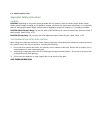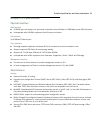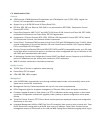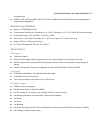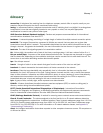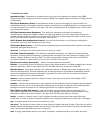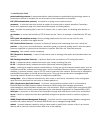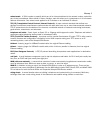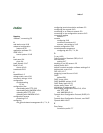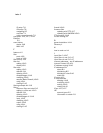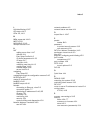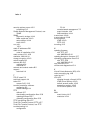4 Administration Guide
packet-switching network: A telecommunications network based on packet-switching technology, wherein a
transmission channel is occupied only for the duration of the transmission of the packet.
PAP (PPP authentication protocol): A method for ensuring secure network access.
parameter: A numerical code that controls an aspect of terminal and/or network operation. Parameters
control such aspects as page size, data transmission speed, and timing options.
port: A location for passing data in and out of a device, and, in some cases, for attaching other devices or
cables.
port number: A number that identifies a TCP/IP-based service. Telnet, for example, is identified with TCP port
23.
POTS (plain old telephone service): Ordinary analog telephone service such as that used for voice
transmission, as distinct from digital service.
PPP (Point-to-Point Protocol): A protocol for framing IP packets and transmitting them over a serial line.
protocol: A set of rules for communication, sometimes made up of several smaller sets of rules also called
protocols. AppleTalk is a protocol that includes the LocalTalk, EtherTalk, and TokenTalk protocols.
remapping: See network number remapping.
RFC (Request for Comment): A series of documents used to exchange information and standards about the
Internet.
RIP (Routing Information Protocol): A protocol used for the transmission of IP routing information.
RJ-11: A telephone-industry standard connector type, usually containing four pins.
RJ-45: A telephone-industry standard connector type usually containing eight pins.
router: A device that supports network communications. A router can connect identical network types, such as
LocalTalk-to-LocalTalk, or dissimilar network types, such as LocalTalk-to-Ethernet. However—unless a gateway is
available—a common protocol, such as TCP/IP, must be used over both networks. Routers may be equipped to
provide WAN line support to the LAN devices they serve. They may also provide various management and
monitoring functions as well as a variety of configuration capabilities.
routing table: A list of networks maintained by each router on an internet. Information in the routing table
helps the router determine the next router to forward packets to.
SDLC (Synchronous Data Link Control): A link-level communications protocol used in an International
Business Machines (IBM) Systems Network Architecture (SNA) network that manages synchronous,
code-transparent, serial information transfer over a link connection. SDLC is a subset of the more generic HDLC
(High-Level Data Link Control) protocol developed by the International Organization for Standardization (ISO).
serial port: A connector on the back of the workstation through which data flows to and from a serial device.
server: A device or system that has been specifically configured to provide a service, usually to a group of
clients.
SNMP (Simple Network Management Protocol): A protocol used for communication between management
consoles and network devices. The Netopia ISDN Router can be managed through SNMP.
subnet: A network address created by using a subnet mask to specify that a number of bits in an internet
address will be used as a subnet number rather than a host address.



